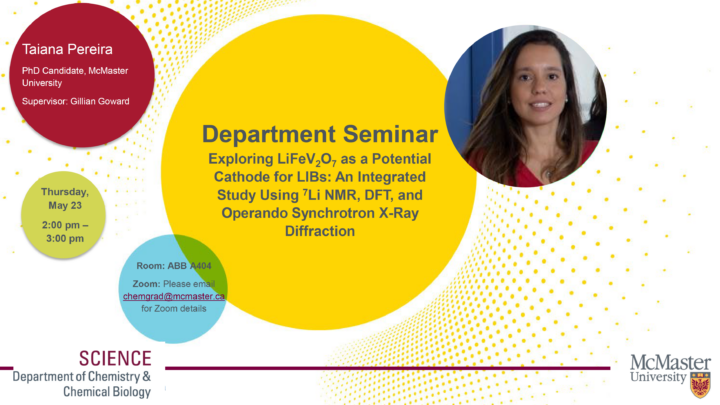PhD seminar – Taiana Pereira
May 23, 2024
2:00PM to 3:00PM

Date/Time
Date(s) - 23/05/2024
2:00 pm - 3:00 pm
Please join us on May 23 for Taiana Pereira’s PhD seminar which will be offered in person and online.
Title: Exploring LiFeV2O7 as a Potential Cathode for LIBs: An Integrated Study Using 7Li NMR, DFT, and Operando Synchrotron X-Ray Diffraction
Date: Thursday, May 23
Time: 2:00 pm to 3:00 pm
Room: ABB A404
Zoom: Please email chemgrad@mcmaster.ca for details.
Host: Gillian Goward
Abstract: With the advancement of technology and environmental problems, the search for clean energy and its storage has grown over the years. Lithium-ion batteries (LIBs) are the most promising energy storage option on the market and have been widely used since their commercialization in the early 90s, due to their high energy density, minimal memory effect, and low self-discharge. The cathode has an essential role in electrochemical performance since it affects the total energy and power output. A full understanding of cathode structure and its structural evolution is essential to understanding its performance. Research on cathodes based on vanadium oxides has been growing, since they exhibit good electronic conductivity, high energy density, chemical stability, and offer four oxidation states that provide a wide range of capacities. 7Li solid-state nuclear magnetic resonance (ssNMR), X-ray diffraction, and density functional theory (DFT) were used to investigate the lithium-ion dynamics and structural changes in the novel cathode material LiFeV2O7.The research employs advanced DFT calculations to predict the electronic structure and 7Li NMR shifts. These theoretical insights are essential for understanding how structural disorder influences NMR results and how the oxidation state of transition metal impacts the Fermi contact shift. Experimental techniques, including ssNMR spectroscopy and diffraction methods, are applied to study the lithium-ion exchange process and structural evolution during electrochemical cycling. Selective inversion NMR experiments were used to quantify the exchange rates relative to lithiation levels, and in combination with diffraction methods and DFT calculations, enabled the development of a structure model that elucidates the corresponding phase changes in the material. The modeled phase revealed that the new arrangement makes it easier for lithium to move around by creating a wide bottleneck and reducing Li-Li distance. Furthermore, the activation energy rises with lithiation levels, indicating that lithium vacancies significantly influence the current dynamics. Overall, this research contributes significantly to the field of LIBs, offering novel insights into the complex interplay between structure, dynamics, and electrochemical performance in cathode materials.
